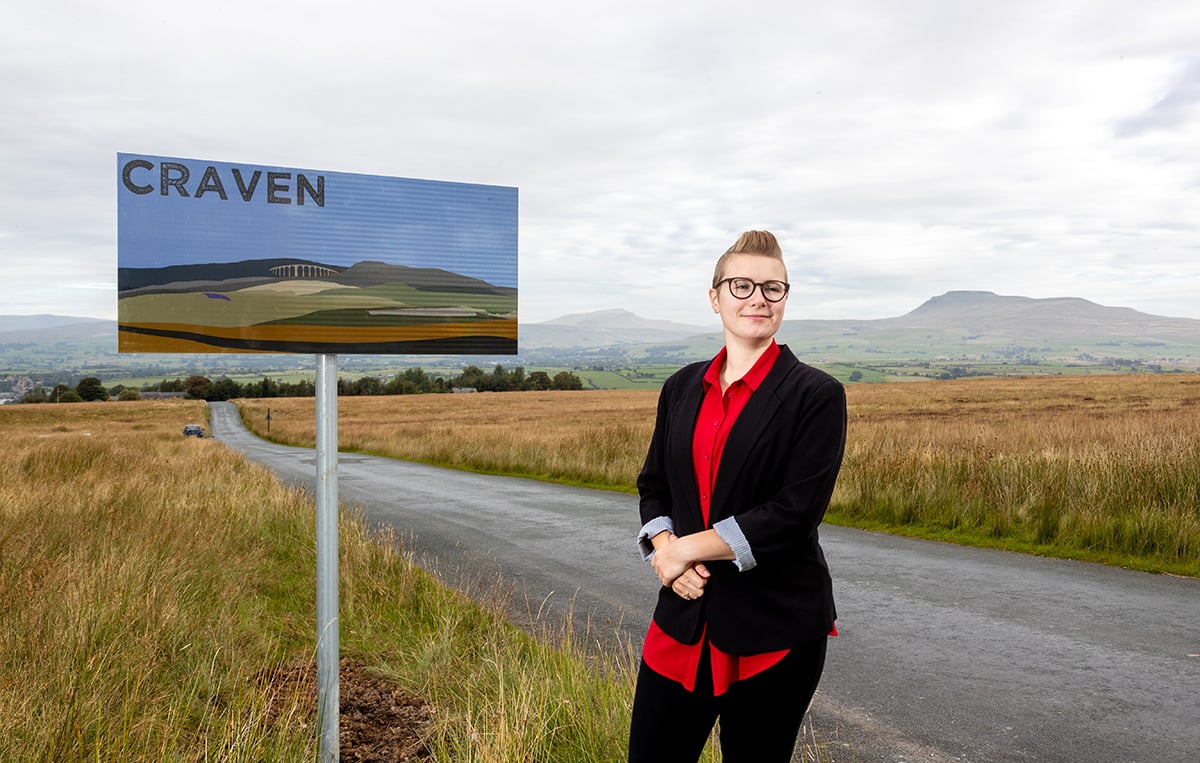
Artist Mary Woolf with Boundary Line Sign
Photo: Stephen Garnett
The public art of placemaking
Public art can connect us to the places, landscapes and buildings where we live. Lindsey Hebden explains what that means in practice for young people in the Lakes and Dales.
The value of public art has never been clearer. More than ever, people are aware of their need to connect with our physical, natural and mental environments, to find space to think and to try and process what is happening right now.
The world is looking at rural places such as the Lakes and Dales through new glasses. Public art can open access to everyone in different, creative and safe ways. It can and does provoke debate, but it can help create identity too by connecting us with the landscapes and our own minds. It stimulates thinking and helps us navigate both rural and urban spaces, digitally and physically, aesthetically engaging us individually and collectively.
It can create a sense of place and evoke a sense of ‘me’.
But can we influence national planning policy to not only support but embrace cultural wellbeing and ensure it is implemented through artistic expression in our natural and built landscapes? I believe we can, in the context of recovery.
Isolation, grief, anxiety and stress borne from this ongoing pandemic can’t be fixed overnight but art can help us find space to connect, reflect and remember those we have lost and those in pain. It can and will help us heal.
Placemaking
Great Place: Lakes and Dales (GPLD), an Arts Council England and National Lottery Heritage Fund-supported programme, aims to change perceptions of the area.
Younger generations are choosing to leave in favour of places which are seen as more affordable with better career opportunities and the Lakes and Dales need to attract diverse, dynamic individuals to live there. As the area's population continues to age, the declining economy needs to be reversed and vibrancy and vitality driven through our towns, villages and communities.
But what roles can public art play in this? We want public art to reflect creative thinking and connect us to the places, landscapes and buildings that make up the Lakes and Dales. As a place marketing tool it can help us embrace and showcase the area’s distinctiveness and unique characteristics – its heart and its identity.
Putting the rural in creativity and art in the everyday will also help the area’s appeal. Involving artists in collaborations from the outset and encouraging developers and planners to work with our young creative champions is vital. Together, they can uncover the heritage and stories of our great place.
Public Art Now!
A rewarding journey of illuminating conversations, creative collaborations and extensive research culminated in the launch of Public Art Now! earlier this year. This GPLD campaign uses arts and culture to change perceptions of the area among young people, and has provided us with a robust and insightful study and, most importantly, a path to do things differently.
We wanted to reinvent and redefine what public art can be to younger audiences. The campaign has explored the relationship of public art with the Lakes and Dales area, reviewing existing strategies and policies and working with the Craven and South Lakeland local authorities, the Yorkshire Dales and Lake District national parks, artists, creative businesses, cultural organisations and developers to identify how best to ensure young voices are heard and represented.
Public Art Now! not only promotes the benefits of public art and how it is interpreted but it advises on commissioning and supports our cultural communities. Crucially, it makes us think about the place we live in, advocating the use of public art to attract younger residents.
Making this happen
Meaningful impacts of public art rely on us working inclusively as partners. In the Lakes and Dales that means nurturing young artistic talent and supporting our creative local communities to ensure diverse cultural organisations and individuals are represented, and fostering the four principles proposed by Public Art Now! – place; empowering young voices; collaborative learning; and advocacy.
GPLD projects already in development include a competition to build flexible, design-led, affordable housing; Watch this Space, 48 hour take-overs by young artists in under-used spaces across the region; Fresh Perspective and The Fold, two inspiring groups of local young people designing and programming cultural activity (including digital zines, outdoor murals, architectural landscaping in places such as a local skatepark and workshops); and new boundary signage for Craven, produced by a young local artist and photographer who depicted the outstanding natural beauty of the landscapes of the Dales.
What’s next?
Now is the time to build on these foundations and incorporate our learning and experience into our ways of working. We must also lobby for art to be embedded in planning and make sure developers start talking to artists early on.
Great Place Lakes and Dales and its partners can continue to communicate, influence and provide guidance through campaigns such as Public Art Now! However, we also need to realise its ambitions by prioritising proposed projects in partnership. This includes master planning, meanwhile uses, a symposium, and material guidance to ensure a public art narrative is embedded in place shaping and planning.
As Mark Twain said: “The future isn’t what it used to be.” Encouraging us to make public art accessible to all communities and generations, putting creativity into our everyday experiences – and fully appreciating its benefits – will help us navigate new landscapes. Public art is anything we want it to be; we just need to ensure it can be.
Lindsey Hebden is Programme Manager for Great Place: Lakes and Dales
Join the Discussion
You must be logged in to post a comment.